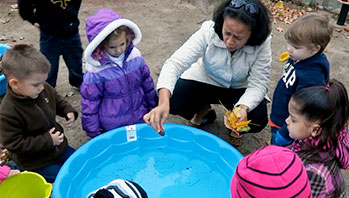- camera or cell phone with camera
- crayons
- leaf
- magnifying lenses
- outdoor rules chart (from Day 1)
- paper sack or plastic baggies (for collecting)
- string (or something to mark off a circle area on the ground)
- science journals
- environment
- ground
- grow
- leaves
- magnifying lens
- plant
- texture
MA Standards
Language/L.PK.MA.6: Use words and phrases acquired through conversations, listening to books read aloud, activities, and play.
MA Draft Standards
Life Sciences/Ecosystems; Biological Evolution/LS2/4.D Determine the variety of living things in a local area and characteristics of the places where they were found.
Head Start Outcomes
Logic and Reasoning/Reasoning and Problem Solving: Classifies, compares, and contrasts objects, events, and experiences.
Science Knowledge/Scientific Skills and Method: Uses senses and tools, including technology, to gather information, investigate materials, and observe processes and relationships.
Science Knowledge/Scientific Skills and Method: Observes and discusses common properties, differences, and comparisons among objects.
Science Knowledge/Scientific Skills and Method: Collects, describes, and records information through discussions, drawings, maps, and charts.
Science Knowledge/Conceptual Knowledge of Natural and Physical Worlds: Observes, describes, and discusses living things and natural processes.
PreK Learning Guidelines:
English Language Arts/Language 2: Participate actively in discussions, listen to the ideas of others, and ask and answer relevant questions.
Science and Technology/Inquiry Skills 4: Record observations and share ideas through simple forms of representation such as drawings.
Science and Technology/Living Things and Their Environment 15: Use their senses of sight, hearing, touch, smell, and taste to explore their environment using sensory vocabulary.
Explore Together (outdoors): Plants on the Ground #1

© Commonwealth of Massachusetts, Department of Early Education and Care. All rights reserved.
STEM Key Concepts: There are many different types of plants and seeds; Plants have different parts: roots, stems, leaves, and fruit; Plants grow in many places; Plants grow in places where they get their needs met; Plants often grow in some type of dirt
ELA Focus Skills: Compare and Contrast, Follow Directions, Speaking and Listening, Vocabulary
Safety Tips:
- Be aware of and check areas for poison ivy, poison sumac, nettles and bushes with thorns before taking children outside.
- Remind children to wash their hands before and after the activity.
- Remind children not to eat ANY plants or touch any plants without asking an adult.
- Take children’s allergies into account before going outside.
Tell children they are going to go outside today and work in small groups to explore plants in the environment and plant parts that they find on the ground.Tell them that you will mark off a circle area outside with a piece of string. Explain that you want them to find as many plants and plant parts as they can inside that circle.
Review the outdoor rules chart from Day 1. Then take children outdoors to a grassy area. Hold up a magnifying lens and tell children what it is called. Explain that a magnifying lens makes things appear bigger when you look through it. Have children hold the leaf and look at it through the magnifying lens. Ask them to describe what they see.
Then mark a circle area with string on the ground. Distribute magnifying lenses and encourage children to use them to look closely at any plants within the circle so they can see small details on the plants. Allow children to explore freely and share their findings with one another. Circulate among groups, listen for things that spark their curiosity, and expand their findings by asking questions such as,
- How can you describe the plant? Its leaves? Its stem? What colors, sizes, shapes, or textures do you observe?
- What do you notice about the grass Jannelle found that is different from the grass you found?
- What is keeping the plant attached to the ground? (With guidance, allow child to very gently tug at a plant to feel how securely it is attached.)
Encourage children to draw or write in their science notebooks so they can share their findings with the group. Before returning inside, ask them to look on the ground for leaves, seeds, twigs, needles, nuts, etc. Have each child bring in two more samples and place them at the Science Table after they share. Tell children they will explore the samples during the week.
Reflect and Share
Have children share their science notebook entries and their findings and describe what they observed. Guide the discussion with questions such as,
- What kinds of things did you find on the ground?
- What was different about the leaves Emily’s group found and the leaves Jeremy’s group found? Why do you think they were different?
- What was the same about the plants you observed? What was different?
